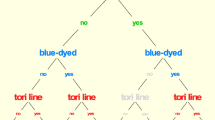Abstract
To improve the performance of tori-lines (bird-scaring lines) in reducing incidental catch of large seabirds (albatrosses and giant petrels) in the pelagic longline fishery, we analyzed factors affecting the performance of tori-lines based on data collected by Japanese scientific observers in the southern bluefin tuna Thunnus maccoyii fishery from 2002 to 2005. We classified the variety of tori-lines by the main tori-line length and the streamer type. Two types of streamers were identified: type A, several long streamers made of nylon cord attached to the main tori-line by metal swivels; type B, many short streamers made of polypropylene packing bands braided into the main tori-line. In a model analysis, we found that the main tori-line length was an important factor affecting tori-line performance, and the two types of streamers had similar effectiveness. Since the light type B streamer has the advantage of practical feasibility, this type can be another option for use in tori-lines if used with a main tori-line of sufficient length.



Similar content being viewed by others
References
Brothers N (1991) Albatross mortality and associated bait loss in the Japanese longline fishery in the Southern Ocean. Biol Conserv 55:255–268
FAO (Food and Agriculture Organization of the United Nations) (2008) Report of the Expert Consultation on Best Practice Technical Guidelines for IPOA/NPOA—Seabirds. FAO Fisheries and Aquaculture Report. No. 880. FAO, Rome
WCPFC (Western and Central Pacific Fisheries Commission) (2007) Conservation and management measure to mitigate the impact of fishing for highly migratory fish stocks on seabirds (conservation and management measure 2007-04). WCPFC, Tumon
IOTC (Indian Ocean Tuna Commission) (2008) Resolution 08/03 on reducing the incidental bycatch of seabirds in longline fisheries. IOTC, Muscat
Kiyota M (2002) Incidental take of seabirds in longline fisheries: nature of the issue and measures for mitigations. J Yamashina Inst Ornithol 34:145–161 (in Japanese with English abstract)
Bull LS (2007) Reducing seabird bycatch in longline, trawl and gillnet fisheries. Fish Fish 8:31–56
Kiyota M, Yokota K (2010) Review of bycatch mitigation measures in tuna longline fishery. Nippon Suisan Gakkaishi 76:348–361 (in Japanese with English abstract)
Barnes KN, Ryan PG, Boix-Hinzen C (1997) The impact of the hake Merluccius spp. longline fishery off South Africa on procellariiform seabirds. Biol Conserv 82:227–234
Løkkeborg S (1998) Seabird by-catch and bait loss in long-lining using different setting methods. ICES J Mar Sci 55:145–149
Boggs HC (2001) Deterring albatrosses from contacting baits during swordfish longline sets. In: Melvin EF, Parrish JK (eds) Seabird bycatch: trends, roadblocks, and solutions. University of Alaska Sea Grant, Fairbanks, pp 79–94
CCAMLR (Convention on the Conservation of Antarctic Marine Living Resources) (2005) CCAMLR conservation measure 25-02. Minimisation of the incidental mortality of seabirds in the course of longline fishing or longline fishing research in the convention area. CCAMLR, Hobart
Ashford JR, Croxall JP, Rubilar PS, Moreno CA (1995) Seabird interactions with longline operations for Dissostichus eleginoides around South Georgia, April to May 1994. CCAMLR Sci 2:111–121
Belda EJ, Sánchez A (2001) Seabird mortality on longline fisheries in the western Mediterranean: factors affecting bycatch and proposed mitigating measures. Biol Conserv 98:357–363
Sánchez A, Belda EJ (2003) Bait loss caused by seabirds on longline fisheries in the northwestern Mediterranean: is night setting an effective mitigation measure? Fish Res 60:99–106
Faraway JJ (2006) Extending the linear model with R: generalized linear, mixed effects and nonparametric regression models. Chapman & Hall, New York
Klaer N, Polacheck T (1998) The influence of environmental factors and mitigation measures on by-catch rates of seabirds by Japanese longline fishing vessels in the Australian region. EMU 98:305–316
Brothers N, Gales R, Reid T (1999) The influence of environmental variables and mitigation measures on seabird catch rates in the Japanese tuna longline fishery within the Australian Fishing Zone, 1991–1995. Biol Conserv 88:85–101
Crawley MJ (2005) Statistics: an introduction using R. John wiley, Chichester
Venables WN, Ripley BD (1999) Modern applied statistics with S-plus, 3rd edn. Springer, New York
Burnham KP, Anderson DR (2002) Model selection and multimodel inference: a practical information—theoretic approach, 2nd edn. Springer, New York
Kiyota M, Okamura H (2005) Harassment, abduction, and mortality of pups by nonterritorial male northern fur seals. J Mammal 86:1227–1236
Hunn N (1994) Diving depth of white-chinned petrels. Conder 96:1111–1113
Melvin EF, Guy TJ, Read LB (2010) Shrink and defend: a comparison of two streamer line designs in the 2009 South Africa tuna fishery. Agreement on the conservation of albatrosses and petrels. Third meeting of Seabird Bycatch Working Group, Mar del Plata, Argentina
Phillips RA, Silk JRD, Croxall JP, Afanasyev V (2006) Year-round distribution of white-chinned petrels from South Georgia: relationships with oceanography and fisheries. Biol Conserv 129:336–347
Péron C, Delord K, Phillips RA, Charbonnier Y, Marteau C, Louzao M, Weimerskirch H (2010) Seasonal variation in oceanographic habitat and behaviour of white-chinned petrels Procellaria aequinoctialis from Kerguelen Island. Mar Ecol Prog Ser 416:267–284
Acknowledgments
We are grateful for the effort of scientific observers in collecting data and valuable information often under severe conditions at sea. We thank Dr. O. Sakai of National Research Institute of Far Seas Fisheries for information on the southern bluefin tuna fishery. Two anonymous reviewers provided helpful comments on a draft manuscript. The scientific observer program has been managed by Federation of Japan tuna fisheries and Japan Fisheries Resource Conservation Association. This study was conducted as a part of the Program on the International Fishery Resources Survey, Fisheries Agency, Japan.
Author information
Authors and Affiliations
Corresponding author
Rights and permissions
About this article
Cite this article
Yokota, K., Minami, H. & Kiyota, M. Effectiveness of tori-lines for further reduction of incidental catch of seabirds in pelagic longline fisheries. Fish Sci 77, 479–485 (2011). https://doi.org/10.1007/s12562-011-0357-4
Received:
Accepted:
Published:
Issue Date:
DOI: https://doi.org/10.1007/s12562-011-0357-4




